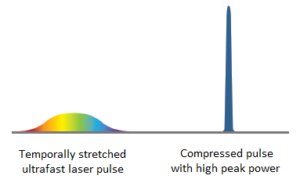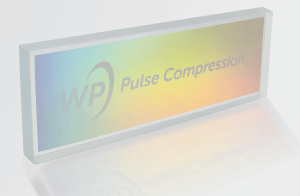Laser pulses are stretched differentially by wavelength in the time domain when passing through optical materials. This particularly affects ultrashort lasers as it becomes more apparent at extremely short pulse durations. Laser pulse compression is a well-known method to reduce the duration of a laser pulse in order to recompress the stretched pulse length, as after amplification of light in a chirped pulse amplifier (CPA).
What stretches an ultrashort laser pulse?
 In materials of optical components such as lenses or fibers, the speed of light is dependent on the wavelength of the passing light. In general, the longer wavelengths propagate with higher speed of light than the shorter wavelengths in the material. This results in a time delay between the wavelength parts. In case of wave packets such as laser pulses, it leads to a temporally stretched pulse, depending on the dispersion strength of the optic material. Laser pulse compression enables you to counteract the stretching of the pulse length to regain or even shorten the original pulse length.
In materials of optical components such as lenses or fibers, the speed of light is dependent on the wavelength of the passing light. In general, the longer wavelengths propagate with higher speed of light than the shorter wavelengths in the material. This results in a time delay between the wavelength parts. In case of wave packets such as laser pulses, it leads to a temporally stretched pulse, depending on the dispersion strength of the optic material. Laser pulse compression enables you to counteract the stretching of the pulse length to regain or even shorten the original pulse length.
What do I need to compress laser pulses?
The laser pulses from ultrafast lasers consist of a broad range of optical frequencies. The shorter the temporal length of the pulse, the broader the frequency spectrum. That means that ultrashort pulses offer plenty of frequencies that can be delayed against each other due to dispersion, thus broadening the pulse length. The physical principle behind laser pulse compression is a delay of particular frequency components in the pulse spectrum so that the overall pulse is temporally recompressed.
Generally, you can distinguish between linear pulse compression and nonlinear pulse compression. In nonlinear laser pulse compression, the laser pulse first passes through a nonlinear medium which spectrally broadens the pulse through a nonlinear interaction such as self-phase modulation. The spectrally broadened laser pulse is usually chirped, and must be temporally compressed by means of linear laser pulse compression.
Linear laser pulse compression depends on optical dispersive components that act as temporal delay lines for individual frequency components. This is possible using prisms or gratings.
Chirped Pulse Amplification (CPA)
 Laser pulse compression is also employed in chirped pulse amplifiers (CPAs). CPAs are used to amplify ultrashort laser pulses safely, as their high peak powers would cause rapid and catastrophic damage in traditional amplifier designs. First, the laser pulse is split into its spectral components in a pulse stretcher using one or more dispersive elements. The spectrally separated and amplified laser pulse is then routed through a pulse compressor with additional dispersive elements that recombine the frequency components back into a single laser pulse. In the case of using gratings as dispersive elements, tilting the grating(s) changes the individual path lengths of different spectral components. By this means, the faster wavelengths can be delayed separately relative the slower wavelengths which results in temporal laser pulse compression.
Laser pulse compression is also employed in chirped pulse amplifiers (CPAs). CPAs are used to amplify ultrashort laser pulses safely, as their high peak powers would cause rapid and catastrophic damage in traditional amplifier designs. First, the laser pulse is split into its spectral components in a pulse stretcher using one or more dispersive elements. The spectrally separated and amplified laser pulse is then routed through a pulse compressor with additional dispersive elements that recombine the frequency components back into a single laser pulse. In the case of using gratings as dispersive elements, tilting the grating(s) changes the individual path lengths of different spectral components. By this means, the faster wavelengths can be delayed separately relative the slower wavelengths which results in temporal laser pulse compression.
Pulse compression gratings from Wasatch Photonics
 At Wasatch Photonics, we have developed volume phase holographic (VPH) gratings that are ideally suited for laser pulse compression in ultrafast laser applications, with exceptional 1st order diffraction efficiency (up to 98%!). Gratings offer better optical design flexibility than prisms over broad angular and spectral bandwidths. Increasing beam sizes and higher intensities require scalability for optical components such as gratings.
At Wasatch Photonics, we have developed volume phase holographic (VPH) gratings that are ideally suited for laser pulse compression in ultrafast laser applications, with exceptional 1st order diffraction efficiency (up to 98%!). Gratings offer better optical design flexibility than prisms over broad angular and spectral bandwidths. Increasing beam sizes and higher intensities require scalability for optical components such as gratings.
Our in-house custom grating design team provides expertise for application-specific solutions in laser pulse compression, and the requisite quality control over wavefront and spatial homogeneity needed to maximize peak power. Learn more about our laser pulse compression grating capabilities here, or contact us to begin a conversation with our team today.


